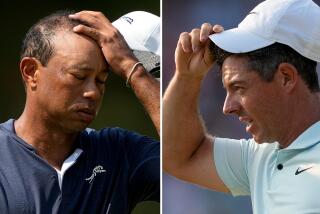BRITISH OPEN : Did Pavin Open Door to a Jinx?
- Share via
ST. ANDREWS, Scotland — On Sunday, June 18, a terrible thing happened to Corey Pavin.
He won the United States Open.
Now, on the face of it, this seemed like a lifetime dream come true. It was true he went to join Ben Hogan, Gene Sarazen, Byron Nelson, Walter Hagen and all the legends who have won this storied tournament.
On the other hand, he went to join Curtis Strange, Payne Stewart, Tom Kite, Andy North and, perhaps, Scott Simpson, who have also won it.
Winning the Open can be a crowning achievement. Or your worst nightmare.
Some guys are superstitious about leaving hats on beds, about the color green. They won’t walk under ladders, cross behind black cats and they throw salt over their shoulder to ward off hexes when they spill it.
To this list of pieces of bad luck, they should add winning the Open.
Curtis Strange compounded his offense. He won two U.S. Opens. Back to back. Infuriated the spirit world. Who did he think he was?
That second U.S. Open was the last tournament he has won. That was 1989. He was only 34. He had won 16 tournaments before that. He has won none since.
You think there isn’t a malicious little demon lurking in the woods just waiting for guys to get careless enough to win the Open?
What about Stewart? Here he was, coasting along on the wave of a great career. He had polished off seven victories in a decade and was a favorite in most. Then, he was incautious enough to win the U.S. Open at Hazeltine in 1991.
Stewart couldn’t find a way to win again for years. Until last April, at Houston. There, Payne didn’t so much win a tournament as inherit it. He sat in the clubhouse and watched Scott Hoch blow a seven-stroke lead on the last nine holes to hand the championship to Stewart, considerably to his surprise.
North won the U.S. Open in 1985. He was 35 at the time. He has not won a tournament since. He has won only three tournaments in his entire life. And two of them were U.S. Opens. Talk about tempting fate. Knocking a chip off the shoulder of golf history.
Kite tried all his life to win a “major.” He piled up 16 tournament victories at such places as Doral, Bay Hill, Memphis. He became the tour’s all-time leading money-winner. He used to win a tournament or two a year.
Finally, he won his major--the U.S. Open at Pebble Beach in 1992.
The next year, he appeared to be defying the jinx: he won two early-season tournaments. At Palm Springs and Los Angeles.
He hasn’t won since.
Simpson has won twice since his 1987 Open. David Graham won only once after his Open victory in 1981. And so on.
Sometimes, you think Sam Snead was lucky. Sam never won a U.S. Open. But he went on to win more tournaments (81) than any other player who ever lived--or is ever likely to live.
Tom Watson was not exactly a raging success after his U.S. Open victory in 1982. He has won 32 tournaments--more than any other active tour player--but only four of them after his Open victory. He was only 32 when he won his Open.
So, Corey Pavin has to ask himself, “What have I done?!” He has to grit his teeth, “I know better than to do that!” And crack himself on his forehead with the flat of his fist for being so careless.
He may come to remember that four-wood on the 18th at Shinnecock Hills the way the captain of the Titanic remembers the iceberg or Custer remembers the smoke in the hills.
U.S. Open winners of late are the great sad stories of our time. They may come to be remembered like assassinated Presidents or bystanders in a gang war. They’re like the lost motorists who come up to this inviting castle and then when the count opens the door they notice he has blood on his teeth.
The U.S. Open has blood on its teeth. It may be a vampire in a full-dress suit and a red-lined cape. The U.S. Open turns into a bat.
Pavin seems too nice a guy to have done this to himself. Corey had won 12 tournaments before the Open, most of them as lonely as a night watchman or a forest ranger. Corey’s threesomes were so anonymous, a guy wanted by three states could hide out there.
No more. Pavin is well aware he has lifted a monkey onto his back. To the extent, he has hired a sports psychologist, Dick Coop, to guide him through the rapids of fame.
“It’s not as if it were brain surgery,” Pavin explains. “But you have to learn when and how to say ‘No.’ You have to decide how to hang onto your golf game with all the demands put upon it and you.”
Galleries here at the British Open are well aware who he is and what he has done. “The American champion,” they whisper as he moves into view. “Won with a bonnie four-wood.”
Pavin, for his part, comes to St. Andrews like a kid coming downstairs on Christmas morning. It’s his kind of course, he feels.
Of course, Pavin believes every course is his kind of course. They never made the course he couldn’t wait to get at.
Pavin buzzes around a course like a bee around a rose. He scurries everywhere.
Most golfers play golf as if they were laying sidewalk. Corey plays as if he were double-parked.
Pavin on a course looks like a man searching for a collar button. He peers everywhere. His practice swing looks like a guy swatting a swarm of bees or fighting a duel. He always has this little half-grin on his face. You can’t tell by his face whether Pavin is shooting 60--or 80.
He loves this course because he thinks it invites invented shots. Pavin with a golf club is like Edison with a slide rule. He’d invent shots on the moon.
“I was getting too mechanical, too wooden,” he admits. “Not my style. My style is to maneuver the ball, develop shots. I like to manage my game and not be dragged along by it--and you can manage your game here.
“The first time I played here, I thought ‘What’s the big deal?’ The second day, the wind shifted and brought the bunkers into play. The third day it shifted again and I thought, ‘It’s three different courses!’ ”
Corey is ready for all three. It’s too bad he has that big load. The last time a U.S. Open winner won the British Open the same year was 1982, when Tom Watson did it. Before that, you have to go back to Lee Trevino (1971) and Hogan (1953).
At least, there’s this: There’s no jinx attached to winning the British Open. If he wins here, Pavin will have slain that dragon and will not have to spend the rest of his life wishing that four-wood had missed the green at Shinnecock.
More to Read
Go beyond the scoreboard
Get the latest on L.A.'s teams in the daily Sports Report newsletter.
You may occasionally receive promotional content from the Los Angeles Times.










